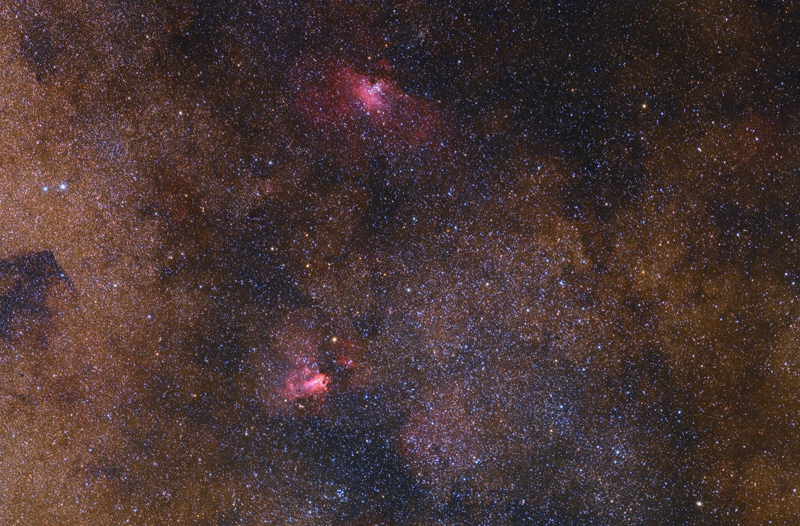
M16
Alternate: NGC 6611, The Eagle Nebula, IC 4703
Serpens
RA 18h 18 m 48 s
Dec -13º 49′
Magnitude 6.0
M17
Alternate: NGC 6618, The Swan Nebula, The Omega Nebula, The Checkmark Nebula, Lobster Nebula
Sagittarius
RA 18h 20 m 26 s
Dec -16º 10′ 36′
Magnitude 6.0
M18
Alternate: NGC 6613
Sagittarius
RA 18h 19.9 m
Dec -17º 08′
Magnitude 7.5
M24
Alternate: IC 4715, The Sagittarius Star Cloud
Sagittarius
RA 18h 17 m
Dec -18º 29′ 00′
Magnitude 4.8
The Messier object rich region of Sagittarius (although M16 is really in Serpens) yields this Cosmic Duet, or in this case multiple. This is a bountiful collection of clusters and nebulae, where M16, M17, and M18 can all be seen within a 4° field-of-view. 7×50 or 10×50 binoculars are all that is required to view this Cosmic multiple.
The Eagle Nebula M16 is a conspicuous region of active star formation, situated in Serpens Cauda. The star forming nebula, a giant cloud of interstellar gas and dust, has already created a considerable cluster of young stars. M16 is most notably famous for being the home of the “the Pillars of Creation”, a feature within the nebula imaged by Hubble Space Telescope. The cluster is also referred to as NGC 6611, the nebula as IC 4703.
The Eagle Nebula was initially discovered by Jean-Philippe Loys de Cheseaux during the period of 1745 to 1746.
M16’s description by Jean-Philippe Loys de Chéseaux in 1745-46 was cataloged as De Chéseaux: No. 4, he wrote: “A star cluster between the constellations of Ophiuchus, Sagittarius, and Antinous [now Scutum], of which RA is 271d 3′ 10″ and southern declination is 13d 47′ 20″.”
Charles Messier rediscovered it on June 3, 1764, describing it as “enmeshed in a faint glow,” suggesting the presence of the nebula. Interestingly, observations by William, John, and Caroline Herschel noted the star cluster but not the nebula.
Located in the Sagittarius arm of our Milky Way Galaxy in a region of star formation, the open star cluster M16 formed. The diffuse Eagle Nebula IC 4703 shines by emission light caused by the high-energy radiation of its massive hot, young stars.
M17 was discovered by Jean-Philippe Loys de Chéseaux during the same period of discovery of M16 in 1745-46. The Omega was one of only six identified by Chéseaux as a nebula in his catalog. As with M16, his discovery was lost and forgotten, until Charles Messier rediscovered it on June 3, 1764.
Jean-Philippe Loys de Chéseaux wrote:
Finally, another nebula, which has never been observed. It is of a completely different shape than the others: It has perfectly the form of a ray, or of the tail of a comet, of 7′ length and 2′ broadth; its sides are exactly parallel and rather well terminated, as are its two ends. Its middle is whiter than the borders; I have found its RA for this year as 271d 32′ 35″ and its southern declination as 16d 15′ 6″. It has an angle [PA] of 50 deg with the meridian.
The Omega Nebula (M17), also called the Swan Nebula, the Horseshoe Nebula, or in the southern hemisphere it is interestingly known as the Lobster Nebula, is a region of star formation and shines by excited emission, caused by the higher energy radiation of young stars. Unlike in many other emission nebulae, however, these stars are hidden within the nebula and cannot be seen in optical images. Star formation may be either still active in this nebula, or may have ceased very recently. A small cluster of about 35 bright but obscured stars seems to be imbedded in the nebulosity.
M18 was discovered by Charles Messier in 1764.
Open cluster M18 is about 0.2 degrees in diameter. M18 appears loose and not dense. Its distance is somewhat in dispute. According to Kenneth Glyn Jones and Robert Burnham, it lies about 4,900 light years distant. But the sources disagree. John Mallas lists the distance as 6,000 light years, and the Sky Catalog 2000 lists the figure as 3,900 light years.
M24 was discovered in 1764 by Charles Messier. M24 is one of the few particular objects, or curiosities, in Messier’s catalog. Messier’s notes list M24 as a large object of 1 1/2 deg in extension, which he included on June 20, 1764, and describes it as “a large nebulosity in which there are many stars of different magnitudes.”
Messier object number 24 is not a “true” deep sky object, but a huge star cloud in our Milky Way. It is a concentration of stars spread thousands of light years along the line of sight, perceived through a chance tunnel in the interstellar dust. They form a portion of a spiral arm of our galaxy.
M16 can be spotted with 7×50 binoculars because of the embedded cluster. On M17, the nebula is obvious in 20×80 or larger binoculars, as an up-side-down swan. The nebulosity is visible with 12×60 binoculars in dark sky conditions. In 7×50 or 10×50 binoculars, M17 appears smaller with much less prominence. When observing the area of M16 and M17, just below the pair is the open cluster M18, appearing like a small glow. Just south of all these is M24 the vast Sagittarius Star Cloud.
Using the ultra-wide field of 2.1×42 binoculars, by lining up at the south end of the star cloud, the observer can look 4° E for M25 and 5° W for M23.